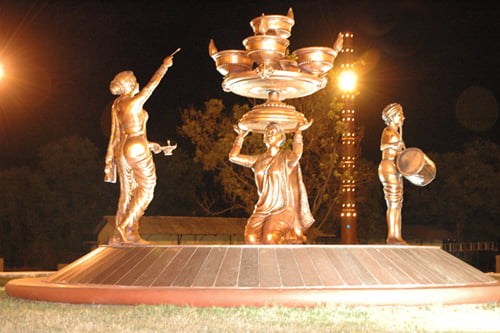Diwali, also known as the Festival of Lights
Primarily celebrated by followers of the Hindu, Sikh, and Jain faiths.
It’s India’s biggest and most important holiday of the year.
The festival gets its name from the row (avali) of clay lamps (deepa) that Indians light outside their homes to symbolize the inner light that protects them from spiritual darkness.
There are several reasons why Diwali is celebrated, and these reasons vary across different regions and religions:
- Return of Lord Rama: One of the main stories in Hindu mythology is that Diwali is the day Lord Rama, his wife Sita Devi, and brother Lakshmana return to their homeland after 14 years in exile. The villagers lit a path for Rama, who had defeated the demon king Ravana⁶. This event is often reenacted as part of the celebrations in some regions.
- Birth of Goddess Lakshmi: Diwali also commemorates the birth of Goddess Lakshmi from Samudra Manthanam, the churning of the cosmic ocean of milk by the gods and demons². Furthermore, Lakshmi picked Vishnu as her spouse and wedded him on Diwali night.
- The defeat of Narakasura by Lord Krishna: In another story, Lord Krishna, an incarnation of Lord Vishnu, slew the demon Narakasura, freeing 16,000 ladies who had been imprisoned. People in certain parts of India celebrate Narak Chaturdashi as the day Krishna killed Narakasura.
- Return of Pandavas: The five Pandava brothers returned to Hastinapur on Kartik Amavasya after being exiled for 12 years due to a lost gambling bet.
- Liberation of Guru Hargobind: On Diwali, Mughal ruler Jahangir liberated Guru Hargobind, the sixth Sikh Guru, and 52 other Hindu princes from prison.
- Mahavira Nirvana Diwas (Nirvana Day): Jains observe Diwali as the day when Lord Mahavira achieved Moksha or salvation.
The celebration involves lighting diyas (oil lamps), decorating homes, exchanging gifts, feasting on sweets, setting off fireworks, and gathering with family.
It’s a time for new beginnings and signifies the victory of light over darkness…
Watch India’s Diwali Festival of Lights
The ancient Indian festival is celebrated with great enthusiasm and fun in various parts of the country. Here’s how Diwali is celebrated in different regions of India:
North India: The religious significance in Northern India is associated with the return of Lord Rama to Ayodhya with wife Sita and brother Laxman after 14 years of exile. To welcome their homecoming, the people of Ayodhya lighted the entire kingdom with Diyas and fireworks. In North India, the celebrations of Diwali start with Dussehra, where Ramlila, a dramatic rendition of the story of the Ramayan is depicted. In Himachal Pradesh, Delhi, and Punjab people are also engaged in gambling on the festival night, which is considered to be auspicious.
Eastern India: In Eastern India, particularly West Bengal, Odisha, and Assam, Kali Puja is performed to seek the goddess for guidance in overcoming evil and to obtain her blessings for happiness, health, wealth, and serenity.
Western India: Western India is mostly associated with business and trade. The necessary rituals remain the same in Western India, which includes the lighting of lamps, and candles.
Southern India: South Indians commemorate the festival as the day Lord Krishna destroyed the demon Narakasura. It is also believed that Lord Vishnu and Goddess Lakshmi married on this day.
Punjab: For Sikhs, Diwali commemorates Guru Nanak’s release from the Gwalior Fort, which coincides with the Hindu festival of Diwali.
